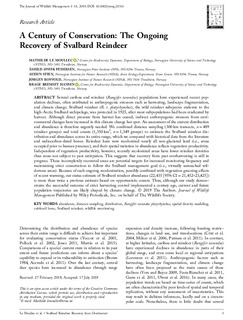| dc.description.abstract | Several caribou and reindeer (Rangifer tarandus) populations have experienced recent population declines, often attributed to anthropogenic stressors such as harvesting, landscape fragmentation, and climate change. Svalbard reindeer (R. t. platyrhynchus), the wild reindeer subspecies endemic to the high‐Arctic Svalbard archipelago, was protected in 1925, after most subpopulations had been eradicated by harvest. Although direct pressure from harvest has ceased, indirect anthropogenic stressors from environmental changes have increased in this climate change hot spot. An assessment of the current distribution and abundance is therefore urgently needed. We combined distance sampling (300 km transects, n = 489 reindeer groups) and total counts (1,350 km2, n = 1,349 groups) to estimate the Svalbard reindeer distribution and abundance across its entire range, which we compared with historical data from the literature and radiocarbon‐dated bones. Reindeer have now recolonized nearly all non‐glaciated land (i.e., areas occupied prior to human presence), and their spatial variation in abundance reflects vegetation productivity. Independent of vegetation productivity, however, recently recolonized areas have lower reindeer densities than areas not subject to past extirpation. This suggests that recovery from past overharvesting is still in progress. These incompletely recovered areas are potential targets for increased monitoring frequency and maintaining strict conservation to follow the Svalbard management goal (i.e., virtually untouched wilderness areas). Because of such ongoing recolonization, possibly combined with vegetation greening effects of recent warming, our status estimate of Svalbard reindeer abundance (22,435 [95% CI = 21,452–23,425]) is more than twice a previous estimate based on opportunistic counts. Thus, although our study demonstrates the successful outcome of strict harvesting control implemented a century ago, current and future population trajectories are likely shaped by climate change. | nb_NO |

